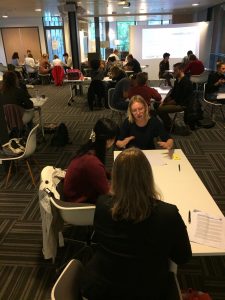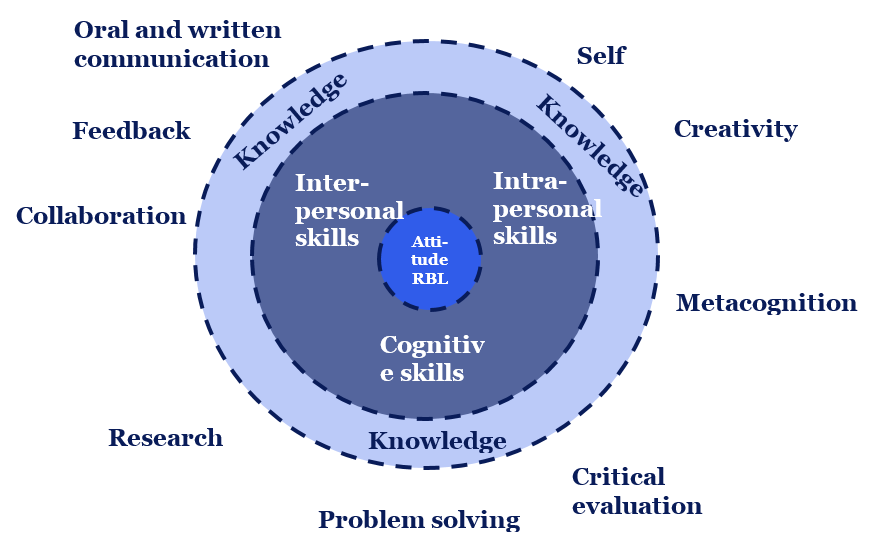
Firstly, the development of a wide range of transferable skills, both discipline-related skills and generic skills, help students prepare for a dynamic and uncertain labour market. They equip students with a mindset for life-long learning, which is an attitude that is helpful as knowledge becomes so easily and relatively quickly outdated.
Secondly, coupling the development of generic skills with content knowledge in an integrated way allows for deep learning. Deep learning in its turn is needed to make knowledge transferable. Generic transferable kills such as writing, presenting, designing research, setting up projects, reflecting on one’s own performance and collaborating, prompt active learning and elicit information processing in depth. Programmes that synthesise knowledge acquisition and transferable skills often employ experiential learning projects to stimulate students. Such projects allow students to acquire and use their knowledge in contexts that mimic professional and research settings. This way they experience the relevance of the knowledge and skills they are acquiring.
Objectives
- Students are trained in a broad range of transferable skills, including discipline-specific skills and generic skills, such as preparing for job applications, coaching skills and entrepreneurial skills.
- Including transferable skills in graduate attributes, guided by the question ‘what kind of students and alumni are considered successful?’.
- Programmes link transferable skills to academic skills; connecting transferable skills to research-based and inquiry-based learning.
- Stimulate an inquisitive attitude in students that enables them to analyse challenges and problems in an academic manner.
What are the key aspects?
The notion of transferable skills is much debated. Transferable skills refer to a wide range of skills, including academic and employability skills. The word ‘transferable’ refers to the acquisition of skills in one context whilst the learner might be able to use the acquired skills in different contexts as well. However, the characterisation of ‘transferable’ can be misleading, because many skills can only be developed successfully when based on previously acquired knowledge. For example, research skills such as literature search, developing research questions and hypotheses rely heavily on content knowledge. When developing the curriculum it is therefore important to consider that students should be offered ample opportunities to practice these skills in different contexts and linked with a variety of content.
Out of the many available transferable skills models, we recommend an adaptation of Pellegrino and Hilton’s model (2012). Their approach resonates with research-based and inquiry-based learning. The model shown below includes the combination of knowledge and skills that continuously interact with each other in teaching and learning (as indicated with the dotted line).

Explanation of the model
The model distinguishes three categories of transferable skills: cognitive skills, interpersonal skills and intrapersonal skills. In educational programmes, these categories are often linked, e.g. research proposals (cognitive skills) are presented (interpersonal skills) and an educational project aimed at solving a societal challenge (cognitive skills) requires time and project management (cognitive and intrapersonal skills). These skills determine how successful a student will be. Note that each overview of transferable skills should remain adaptable to society’s needs and may change over time.
In the heart of the model, ‘Attitude’ and ‘Research-based Learning’ (RBL) are placed to emphasise that skills-training is not limited to learning activities, but also includes developing an academic attitude. Skills-training should start with stimulating an inquisitive mindset in students, to stimulate a positive attitude towards collaboration and accept doubt. Most of the skills-training mentioned above can be employed to build students’ attitude.
The three categories of skills could be extended according to the course programme they are in, resulting in a complete set of 30 or more skills (see for example tip HYPERLINK ). The extensive list of (transferable) skills could raise concern that there are too many to fit in a course programme. However, when the training of skills is taught in conjunction with disciplinary knowledge, not much extra time is needed. Moreover, the students will better engage with the taught knowledge. Therefore, integration of skills with disciplinary content knowledge offers an elegant way forward in curriculum design.
What are important questions?
- Which skills should be included in a particular programme?
- How to avoid a programme overload by adding skills-training to the curriculum? (to follow)
- How to integrate acquisition of content knowledge and skills in an integrated manner? (to follow)
- How to assess interpersonal and intrapersonal skills? (to follow)
- How to use assessment of skills to feed forward? (to follow)
- What are achievable learning objectives of transferable skills? (to follow)
How do you are on the right track?
Making progress comprises (re-)designing education as well as keeping track of results. But how can you know that you are making progress? Summarizing the general process of educational design and specific models for curriculum re-design we propose the following three-step approach:
Step 1. Reformulate the (university’s) objectives into questions concerning the current situation (today) and the desired situation in the future
Step 2. Make the answers to the questions measurable
Step 3. Use the answers as input for further (re-)design
For example:
1) To what extent are students trained in a broad range of skills today and in the future? Examples of measurable answers: (%) cognitive – interpersonal – intrapersonal skills in the program; (%) skills in the curriculum/offered co-curricular/extra-curricular
2) To what extent are transferable skills included in the graduate attributes today and in the future? Examples of measurable answers: (%) graduate attribute describe transferable skills
3) How do programmes link transferable skills to academic skills today and in the future?Examples of measurable answers: by (x) discipline specific skills training
4) How is students’ inquisitive attitude stimulated today and in the future? Examples of measurable answers: by incorporating (x) inquiry projects; by working on interdisciplinary problems in lectures
Further reading
Pellegrino, J. W., & Hilton, M. L. (2012). Education for life and work: developing transferable knowledge and skills in the 21st century. Washington D.C.: National research council of the national academies.
This book elaborates on skills in relation to deep learning and argues how skills enhance deep learning techniques. Recommendations are mainly given at curriculum level. Teachers who want to implement 21st century skills will not find a lot of information here.
Kienzler, H., & Fontanesi, C. (2017). Learning through inquiry: a Global Health Hackathon. Teaching in higher education, 22(2), 129-142.
This article describes ins and outs of a hackathon. A hackathon may be a feasible approach for practising cognitive, interpersonal and intrapersonal skills, in an integrated way. The starting point is challenge in society, and students work for two weeks on it. A hackathon may be an attractive educational approach because it does not require a rigorous innovation in all modules.
Example: curriculum design (Humanities)
Transferable skills: defining, developing and implementing in curricula
Applied in: Faculty of Humanities
Developer: Marlous Dekker (FGW) , Sonja Wagenaar (ICLON)
What is it about?
The Faculty of Humanities carried out some research in 2017-2018 on the concept of transferable skills. The questions posed by this research included:
- What are transferable skills?
- How do you define transferable skills?
- How can you explicitly make sure transferable skills are part of the curriculum?
- How do you make sure students work and reflect on these skills during their studies?
What are the outcomes of the project so far?
First of all, the research looked at definitions and models of transferable skills. The overlap with academic skills was explored and the relationship with life-long learning, employability and research-based learning was specified. Also a model for the Faculty of Humanities was developed, containing nine transferable skills, categorised into three domains: interpersonal, intrapersonal or cognitive skill.
Members of the Transferable Skills workgroup, who were teachers from different programmes, worked on explaining four different skills in detail. They defined these skills, what they involve, explained how the skills could be part of the BA1, BA2 and BA3, and which activities could be used in class to work on these skills in an educational context. The four elected skills were chosen by the teachers themselves, as they identified them as main skills for Humanities and educating students.
Twelve activating practices were gathered in an overview document, three for each of the four skills that were explored in detail. These overviews give teachers a quick reference guide to be able to apply this directly in their teaching, if desired.
In addition, a procedure was developed with which a team of teachers can screen their programme and subjects for transferable skills. Focus lies on which skills are already encountered, but which could be more explicit in our programme? Are skills present in the BA1, BA2 and BA3? Do we feel this as being important? Are there any skills we should address more in the programme? Pilots will be conducted in order to experiment with different approaches for teaching and learning transferable skills.
Example: Collaboration skills: reflecting on team roles by designing a health care centre
Applied in: LUMC, Medicine
Developer: Sara Makkenze
What is it about?
This workgroup is for first-year students in Medicine, and is part of the line Collaboration and Organisation of health care. In teams, students design a health care centre and following that, reflect on their roles.
What are the objectives of the workgroup?
- Students reflect on their roles in the team and the roles of the other team members .
- Students give feedback and they receive feedback.
- Students apply collaborative work in the decision-making process while focusing on health issues.
Description
After receiving instructions about decision-making and team roles, the students discuss in pairs what their normal group behaviour is and what their desired behaviour would be, such as taking the lead or sharing a challenging opinion. The aim is to try out behaviour that is not familiar. On a large piece of paper the group draws the centre with all its facilities, taking all the individual opinions in consideration. Another team carefully observes. After 20 minutes, the observers share their observations. When the other team starts designing, the pressure is enhanced by asking students to stand across the table, working with one pen, and limited time. The wrap-up is focused on reflection. What roles did the students take? What was the effect of their behaviour on decision-making? Who took the lead? To actually apply this to health care, the students are asked to conclude what they have learned as a doctor. Students each upload an observation form and a short reflection to their portfolio. To facilitate observations of concrete behaviour, the observer sits opposite the student whom they need to observe.
